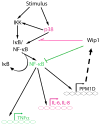Regulation of the Wip1 phosphatase and its effects on the stress response
- PMID: 22201816
- PMCID: PMC3508688
- DOI: 10.2741/3999
Regulation of the Wip1 phosphatase and its effects on the stress response
Abstract
Wip1 (PPM1D) is a stress responsive PP2C phosphatase that plays a key role in stress signaling. Although originally identified as a gene induced by p53 after genotoxic stress, we now know that Wip1 expression is additionally regulated by other mechanisms. Wip1 is not only a target of p53, but is also a target of other transcription factors, including Estrogen Receptor-alpha and NF-kappaB. Additionally, Wip1 expression is regulated by post-transcriptional mechanisms such as mRNA stabilization and alternative splicing. Upon induction, Wip1 dampens the stress response by dephosphorylating and inactivating proteins such as p53, p38 MAPK, and ATM, usually as part of a negative feedback loop. As a result, Wip1 functions to abrogate cell cycle checkpoints and inhibit senescence, apoptosis, DNA repair, and the production of inflammatory cytokines. Furthermore, Wip1 is overexpressed in several types of human cancers and has oncogenic functions. The regulation of Wip1, the role of Wip1 in stress signaling, and the cooperation of Wip1 with oncogenes in promoting tumorigenesis will be discussed in this review.
Figures






Similar articles
-
The type 2C phosphatase Wip1: an oncogenic regulator of tumor suppressor and DNA damage response pathways.Cancer Metastasis Rev. 2008 Jun;27(2):123-35. doi: 10.1007/s10555-008-9127-x. Cancer Metastasis Rev. 2008. PMID: 18265945 Free PMC article. Review.
-
The oncogenic phosphatase WIP1 negatively regulates nucleotide excision repair.DNA Repair (Amst). 2010 Jul 1;9(7):813-23. doi: 10.1016/j.dnarep.2010.04.005. Epub 2010 May 6. DNA Repair (Amst). 2010. PMID: 20451471 Free PMC article.
-
Arsenic trioxide augments Chk2/p53-mediated apoptosis by inhibiting oncogenic Wip1 phosphatase.J Biol Chem. 2008 Jul 4;283(27):18969-79. doi: 10.1074/jbc.M800560200. Epub 2008 May 15. J Biol Chem. 2008. PMID: 18482988
-
The estrogen receptor alpha pathway induces oncogenic Wip1 phosphatase gene expression.Mol Cancer Res. 2009 May;7(5):713-23. doi: 10.1158/1541-7786.MCR-08-0247. Epub 2009 May 12. Mol Cancer Res. 2009. PMID: 19435816
-
WIP1 phosphatase at the crossroads of cancer and aging.Trends Biochem Sci. 2010 Feb;35(2):109-14. doi: 10.1016/j.tibs.2009.09.005. Epub 2009 Oct 29. Trends Biochem Sci. 2010. PMID: 19879149 Review.
Cited by
-
Wip1 inhibitor GSK2830371 inhibits neuroblastoma growth by inducing Chk2/p53-mediated apoptosis.Sci Rep. 2016 Dec 19;6:38011. doi: 10.1038/srep38011. Sci Rep. 2016. PMID: 27991505 Free PMC article.
-
PP2C phosphatases-terminators of suicidal thoughts.Cell Death Dis. 2024 Dec 19;15(12):919. doi: 10.1038/s41419-024-07269-2. Cell Death Dis. 2024. PMID: 39702569 Free PMC article. Review.
-
Binding of a third metal ion by the human phosphatases PP2Cα and Wip1 is required for phosphatase activity.Biochemistry. 2013 Aug 27;52(34):5830-43. doi: 10.1021/bi4005649. Epub 2013 Aug 16. Biochemistry. 2013. PMID: 23906386 Free PMC article.
-
A suppressive role of ionizing radiation-responsive miR-29c in the development of liver carcinoma via targeting WIP1.Oncotarget. 2015 Apr 30;6(12):9937-50. doi: 10.18632/oncotarget.3157. Oncotarget. 2015. PMID: 25888625 Free PMC article.
-
Wild-type p53-induced phosphatase 1 (Wip1) forestalls cellular premature senescence at physiological oxygen levels by regulating DNA damage response signaling during DNA replication.Cell Cycle. 2014;13(6):1015-29. doi: 10.4161/cc.27920. Epub 2014 Jan 31. Cell Cycle. 2014. PMID: 24552809 Free PMC article.
References
-
- Lavin MF, Kozlov S. ATM activation and DNA damage response. Cell Cycle. 2007;6(8):931–42. 4180 [pii] - PubMed
Publication types
MeSH terms
Substances
Grants and funding
LinkOut - more resources
Full Text Sources
Research Materials
Miscellaneous

